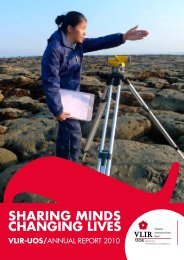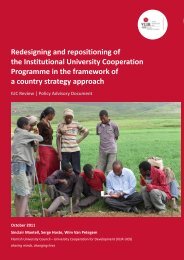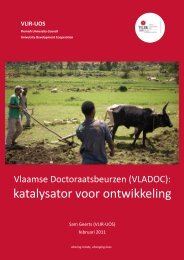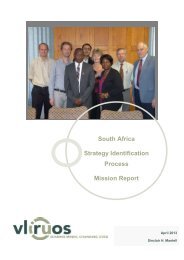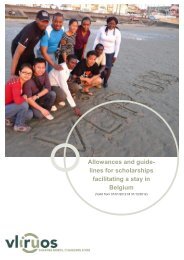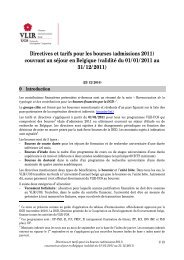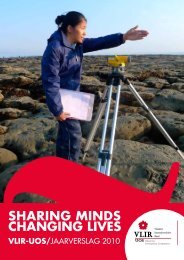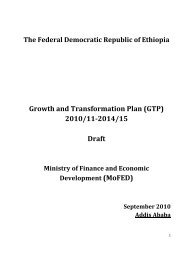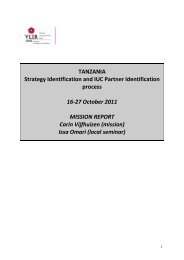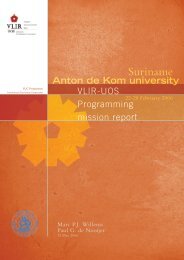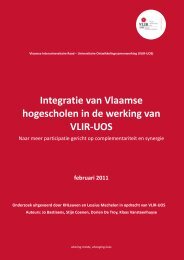Education Sector Development Program - VLIR-UOS
Education Sector Development Program - VLIR-UOS
Education Sector Development Program - VLIR-UOS
You also want an ePaper? Increase the reach of your titles
YUMPU automatically turns print PDFs into web optimized ePapers that Google loves.
<strong>Education</strong> <strong>Sector</strong> <strong>Development</strong> <strong>Program</strong> IV<br />
The enrolment of girls from pastoralist and agropastoralist<br />
areas will increase<br />
The share of girls in TVET enrolment will increase<br />
from 46% in 2008/2009 to 50% in 2014/15.<br />
The enrolment of girls/women in functional adult<br />
literacy programs will increase<br />
The difference between the male and female<br />
literacy rate will decrease<br />
The share of females among teachers will<br />
increase<br />
The share of females among school heads,<br />
experts, supervisors and leaders will increase<br />
The share of females in administrative position at<br />
woreda, regional and federal level and in higher<br />
education will increase<br />
All teachers will use gender sensitive curriculum.<br />
3. Policy and strategies<br />
Integrating gender issues across all levels<br />
of education system is one of the means of<br />
addressing educational equity. Accordingly, the<br />
global goal for gender equality under ESDP IV<br />
will be to promote equal access and success<br />
in education and training for women and girls.<br />
In order to achieve this goal, several mutually<br />
reinforcing strategies will be implemented.<br />
These are in line with the National Action Plan on<br />
Gender Equality in <strong>Education</strong>.<br />
Firstly, the necessary institutional and<br />
structural mechanisms will be put in place<br />
and/or strengthened. The existing strategy and<br />
action plan for gender equality in education<br />
will be updated. Support structures at national,<br />
decentralized and institutional levels will be<br />
strengthened. Further efforts will be made to<br />
establish and strengthen women education<br />
forums at all levels of education. Above all<br />
gender mainstreaming will be implemented<br />
effectively at all levels and efforts will be made<br />
to improve the capacity of the education staff to<br />
mainstream gender issues. One of the strategies<br />
which are known to contribute to the participation<br />
of women in education consists of the setting up<br />
of girl students’ clubs in all levels of education.<br />
Secondly, efforts will continue to focus on<br />
increasing the enrolment, retention and<br />
performance of female students, including girls<br />
from pastoralist and agro-pastoralist groups,<br />
with special attention to their participation in<br />
science and technology. This will take the form of<br />
affirmative action programs and of strategies to<br />
create a conducive learning environment for girls<br />
admitted to TVET after grade 10. At the same<br />
time, more attention will be given to monitor the<br />
implementation of ‘affirmative action’ programs.<br />
The education sector has to create strong work<br />
relationships with line ministries for collaborative<br />
work on gender issues.<br />
Thirdly, the need to raise community awareness<br />
about the benefit of girls’ education and about<br />
harmful traditional practices is still widely<br />
recognized. This includes disseminating lessons<br />
learned about girls’ education in relevant bodies<br />
and in society at large. In order to contribute to<br />
this, a gender sensitive curriculum, textbooks<br />
and reference books will be produced. Specific<br />
attention will be given to the role of women in<br />
pastoralist communities. The sexual harassment<br />
policy will be developed and implemented at<br />
all higher education institutions with serious<br />
commitment of the top managements. Gender<br />
responsive pedagogy (GRP) training in teacher<br />
training institutions will also be provided. The<br />
promotion of women in leadership positions plays<br />
a useful role in combatting gender stereotypes. .<br />
Integrating gender<br />
issues across all levels<br />
of education system<br />
is one of the means of<br />
addressing educational<br />
equity. Accordingly, the<br />
global goal for gender<br />
equality under ESDP IV will<br />
be to promote equal access<br />
and success in education<br />
and training for women<br />
and girls.<br />
73



